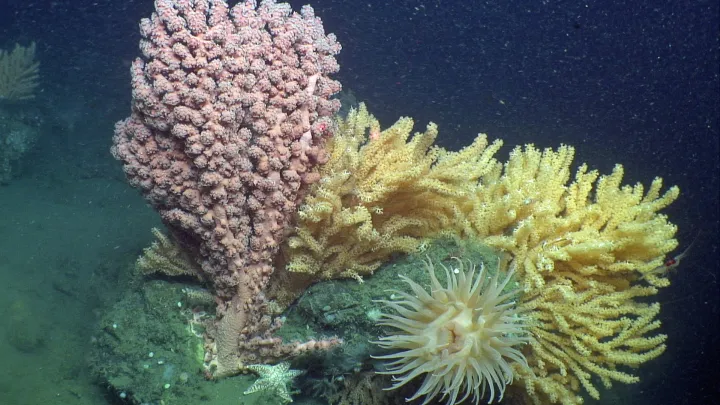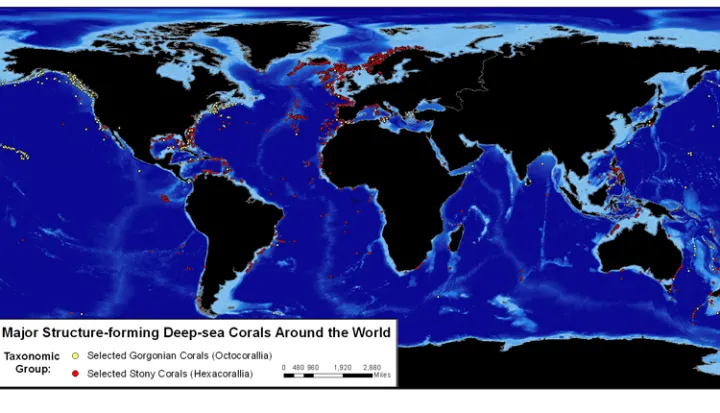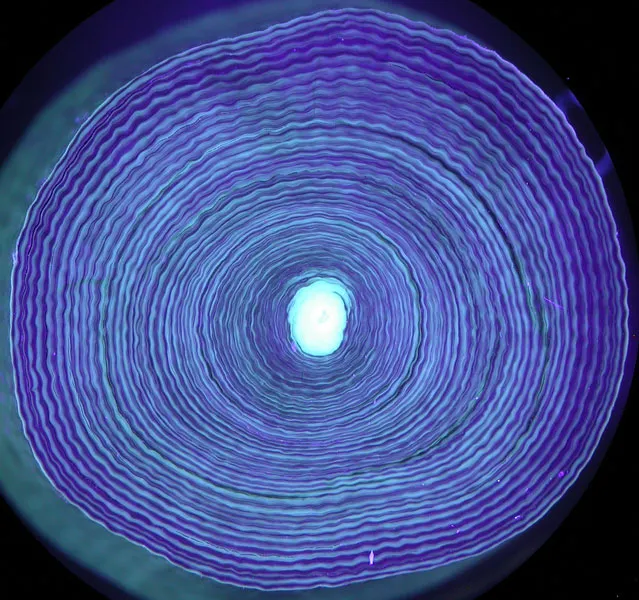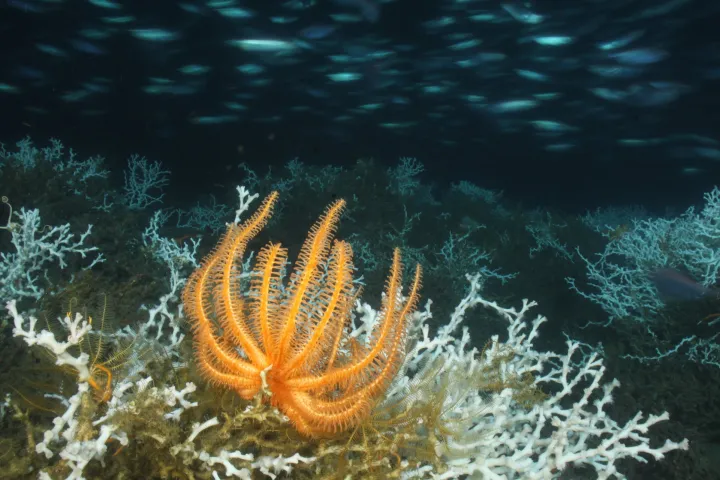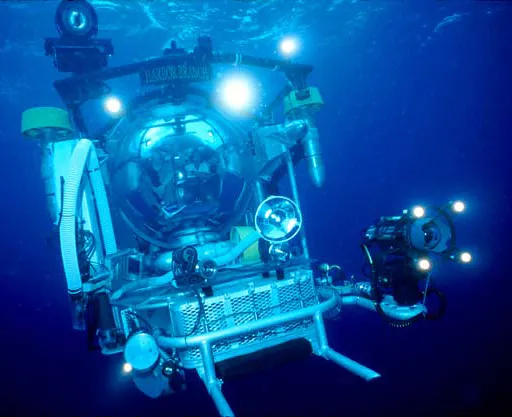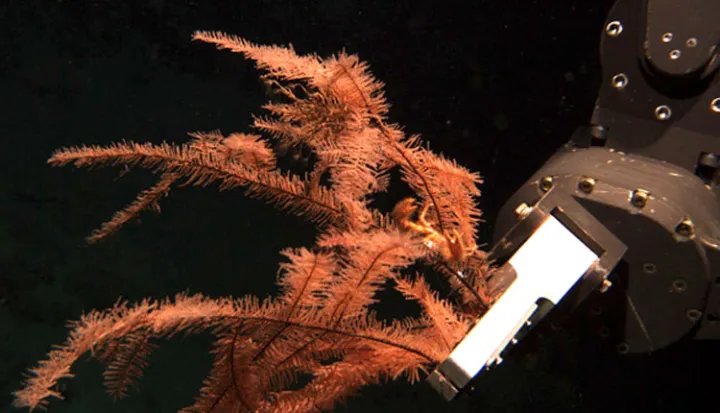
Deep-Sea Corals
Introduction
It may be the last place you’d expect to find corals—up to 20,000 feet (6,000 m) below the ocean’s surface, where the water is icy cold and the light dim or absent. Yet believe it or not, lush coral gardens thrive here. In fact, scientists have discovered more species of deep-sea corals (also known as cold-water corals) than shallow-water species.
What Are Deep-Sea Corals?
Living at Depth
Deep-sea corals, like their name suggests, are corals that live in the deep sea, which is often defined as the depth where light is absent at around 660 feet (200 meters). Like shallow-water corals, deep-sea corals can be just a singular polyp (solitary) or be made up of many polyps (colonial). Many corals may also grow together and form reefs or coral gardens.
Unlike shallow-water corals, deep-sea corals don’t need sunlight to survive. Shallow-water corals are famous for their close relationship with photosynthetic algae called zooxanthellae, but as water gets deeper, light begins to dwindle, and corals have little use for their surface symbionts. In deeper waters coral have no zooxanthellae at all and must catch all their own food. Using their tentacles armed with stinging cells called nematocysts, coral polyps catch drifting particles called marine snow as they fall from productive surface waters.
Where Are Deep-sea Corals Found?
Because deep-sea corals don’t depend on warm water or sunlight, they are able to live in many different places around the world. They are far more widely distributed than scientists previously imagined—living even in waters as cold as -1ºC (30.2ºF).
They grow in all the world’s ocean basins, where they form deep-water havens on continental shelves and slopes, in ocean canyons, and on tall seamounts.
Adaptations to the Deep
Bioluminescence
It is estimated that 76 percent of animals that live in the deep sea can produce their own light through a process called bioluminescence. Many corals that live in the deep sea are bioluminescent. In fact, the earliest known evolution of bioluminescence was in octocorals about 540 million years ago. Species of octocoral like sea pens, bamboo corals, and other soft corals will emit a wave of blue light or green that travels through the colony of polyps. Other corals even produce a glowing green slime. For stationary corals, bioluminescence might act as a burglar alarm to deter predators. If attacked or disturbed, the light that the coral creates can attract other, bigger, predators to chase off the intruders.
Polyps and Position
One of the challenges of the deep sea is that food can be hard to access. Most of life on Earth ultimately relies on energy from the Sun, but the Sun’s rays don’t reach the deep sea. Deep-sea ecosystems often rely on food falling from the surface in the form of marine snow and carried by deep ocean currents. Food that eventually makes its way to the deep sea is often scarce, devoid of nutrients, and inconsistent. Many deep-sea coral species have evolved a few strategies to take advantage of any morsel of food that does get brought down to the seafloor.
Deep-sea stony corals tend to have slightly larger polyps than their shallow water counter parts. In shallow water, most corals live in colonies of hundreds or thousands of polyps that are only a few millimeters in size. However, in the deep sea most stony corals species are single polyp species that can be several inches in diameter.
Furthermore, many deep-sea corals have body shapes and positions that allow their polyps to get the most out of the food bringing deep sea currents. Many deep-sea corals are fanned shaped and will grow perpendicular to the way the currents are moving. This helps to increase the amount of surface area that is in contact with currents carrying marine snow. In black corals, some of the deepest living species grow their branches in a shape that resembles a wind tunnel that helps direct food to all the polyps of the colony.
Growth and Reproduction
Deep-sea corals have slow growth rates and can be astonishingly old. Without the constant energy supplied by the sun, temperatures are low, and resources are often scarce in the deep. According to scientific estimates, one particular colony of gold coral (Kulamanamana sp.) found off the coast of Hawaii was about 2,742 years old. Marine researchers determined that another deep-sea coral colony in Hawaii—this one a black coral (Leiopathes sp.)—was about 4,265 years old. These coral colonies are some of the oldest marine organisms on record.
Because of their longevity, many deep-sea coral species can act as climate databases by giving us a glimpse into past ocean conditions. As they grow, several species of bamboo and black corals produce distinct layers of their skeleton, much like the rings on the trunk of a tree. Scientists can look at the chemical makeup and thickness of each layer to see changes in temperature, acidity, and nutrients in the ocean over the different years of that coral’s life.
For many species of deep-sea coral their method of reproduction is still unknown, but so far scientists have discovered that deep-water corals reproduce in many different ways. Some corals reproduce asexually by forming clones of themselves from broken branches that resettle or by simply budding off a piece of themselves. Other corals reproduce sexually and can do so across and within the same coral colony. Some colonies contain polyps of both sexes, while others have polyps of only one. Other corals reproduce through broadcast spawning where eggs and sperm mix in the water column to create larvae. Others let their young develop into larvae before sending them out into the dark ocean to find a new place to settle in a process called brooding.
Diversity of Deep-Sea Corals
Scientists have identified more than 3,500 species of deep-sea corals, and the numbers keep climbing.
Most coral diversity in the deep sea comes from different species of octocorals, which account for over half of the species of coral found in the deep sea. Octocorals have eight tentacles that surround their mouth and include sea fans, sea pens, bamboo corals and soft corals. Black corals, stony corals, lace corals, and gold corals can also be found in the deep sea.
In contrast, in shallow water stony hexacorals (corals with tentacles in multiples of six) make up the majority of coral species. Stony corals form hard internal skeletons made of calcium carbonate and can form massive reef structures. Stony corals can also be found in deeper depths, although often smaller than their shallow counterparts and as single polyps.
The color of shallow-water corals is determined by their zooxanthellae, so they often come in shades of brown, green, and reds. Deep-sea corals, however, can come in a virtual paint box of colors including bright yellow, deep purple, bubblegum pink, vibrant orange, and more. Deep-sea coral colors come from their tissues or tiny spines in their tissues called sclerites that help give some corals their structure. Their shapes are equally varied and include branching, fan-shaped, and feather-shaped forms, to name a few.
When it comes to size, the range among deep-sea corals is tremendous. Scientists have discovered single polyps as small as a grain of rice, tree-like coral colonies that tower as tall as 35 feet (10 m), and massive coral reefs made of multiple colonies that stretch for 25 miles (40 km).
Deep-Sea Corals as Ecosystems
Deep-sea corals form two different but important habitats on the ocean floor; coral reefs and coral gardens or forests.
Shallow-water stony corals are known for forming large reefs. While most stony corals in the deep sea are solitary cup corals, there are still a few species that can form reefs. In United States waters the most common is Desmophyllum pertusa, which can form reefs hundreds of miles long and over a hundred feet off the seafloor. One of the largest deep-sea coral reefs was only recently fully discovered and stretches over 300 miles from off the coast of Miami, Florida all the way to Charleston, South Carolina.
Deep-sea coral gardens are not as structurally magnificent as deep-sea reefs, but what they lack in size, they make up for in diversity. Unlike deep-sea reefs which are typically dominated by a single species of stony coral, deep-sea coral gardens can contain a wide array of stony corals, octocorals, and black corals all living closely together. The corals can come in a variety of shapes, from fans to thin wispy strands creating a Seussian-like landscape on the seafloor.
Both deep-sea coral reefs and gardens provide crucial habitat on the seafloor. In the deep-sea habitat can be scarce, so when there is structure, life tends to abound around it. With their branching arms, deep-sea corals provide a much-needed refuge from the exposed seafloor to all the other creatures living near the bottom of the ocean. Animals like fish, crustaceans, mollusks, worms, and jellies flock to deep-sea coral habitats for protection from currents and predators, to find food, and to reproduce in a safe place
Creatures of Deep-Sea Coral Habitats
In the ocean’s vast expanse, deep-sea corals provide a precious commodity—habitats for marine life. Invertebrates like worms, starfish, and lobsters as well as vertebrates like fish depend on deep-sea corals. The corals offer food, places to hide from predators, nurseries for juveniles, and a solid surface where invertebrates can take hold.
Brittle Stars
Brittle stars are often found with their long snakelike arms wrapped tightly around deep-water corals. Some brittle stars may spend their whole lives on a single coral, while others can help protect corals from becoming buried in sediment or damage from oil spills.
Squat Lobsters
While these crustaceans look like lobsters, they are actually more closely related to hermit crabs. They also have long arms tipped with claws that can grow to be several times their body length. Positioned atop deep-sea corals, squat lobsters will hold their claws out to the currents, hoping to snap unsuspecting prey that swim by.
Giant Sea Spiders
Several species of sea spiders, also known as pycnogonids, prey on deep-sea corals. They have eight long, jointed and spindly legs, and some can grow as large as three feet across. They have a long tube-like mouths that they use to pierce corals and then suck out the soft tissue.
Lophelia Worms
The polycheate worm Eunice norvegica and other similar species of Eunice worms have a symbiotic relationship with the reef forming deep sea stony corals like Desomophyllum pertusa and Madrepora oculata. The worms create parchments like tubes and build tunnels through the coral branches. This stimulates the coral to grow over the tubes the worm creates, which strengthens the framework of the coral.
Dumbo Octopus
This group of finned octopuses in the genus Grimpoteuthis is the deepest known octopus species. They get their name for the large fins on the sides of their head which they flap to propel themselves along the seafloor. They are about 8 to 12 inches in size and typically live 9,800 ft to 13,000 ft below the surface. At these depths it can be hard to find a safe place to leave eggs. Dumbo octopuses will attach their eggs to deep-sea corals to hide them from predators.
Threats and Solutions
Deep-sea corals may grow in remote locations. But they are not beyond the reach of human activities such as fishing. In fact, fishing efforts have increasingly focused on deeper habitats, intensifying the impact on deep-sea corals. Extracting natural resources from the deep sea, like drilling for oil and mining for minerals, is becoming more and more prevalent as technology advances. And, like all other marine habitats, the threat of climate change continues to worsen as global temperatures rise.
There are many important reasons to preserve deep-sea corals—including the rich biodiversity of the habitats they create, their critical ecological role, and the valuable history of Earth’s ancient climate recorded within them. More and more people are beginning to recognize the critical importance of preserving deep-sea corals. In waters under national jurisdiction as well as in the high seas, these fragile ecosystems are beginning to receive some attention.
Fishing
Damage from fishing gear, especially equipment that trawls the sea bottom, poses a major threat to deep-sea corals. Decades of bottom trawling has been shown to actually smooth out the sea-floor, changing the ecosystem entirely, in addition to destroying deep-sea coral. In recent years, many important habitat forming deep-sea coral species have entered the IUCN Red List as Near-Threatened, Vulnerable, and even Endangered primarily due to fishing activities. It’s estimated that in the last 30 years populations of the black coral Leiopathes glaberrima, one of the longest-lived coral species, have decreased by 1/3 and some local populations may be critically endangered due to fishing . While off the coast of Norway, Desmophyllum pertusa reefs have declined by up to 50 percent and the species is now listed as Vulnerable on the IUNC Red List.
One effective way of protecting deep-sea coral habitats from physical damage caused by fishing gear is by establishing marine protected areas (MPAs) that restrict use of specific fishing gear types. Several such areas have already been created in Alaska and off the west and southeastern coasts of the continental United States. In 2013, Chile became the first country to protect all seamounts from bottom trawling. Unfortunately, however, MPAs cannot protect deep-sea corals from the damage caused by environmental changes such as ocean acidification.
Mining and Drilling
Oil and gas exploration and development also lead to coral reef destruction, particularly when accidents occur. In 2010, the Deepwater Horizon oil spill injured mesophotic and deep-sea corals off the U.S coast from Texas to Florida and there are currently efforts underway to restore them. Because deep-sea corals grow so slowly, they can take decades or even centuries to recover from threats like these—if they recover at all.
The deep sea has many rare earth elements like copper, cobalt, manganese, and nickel that are important in making essential technology like cell phones and electric vehicles. As these elements are depleted on land, manufacturers are looking to the deep sea to try and keep pace with the increased demand for these materials. However, the process of mining these elements from the seafloor also disturbs deep-sea coral and sponge communities. Because of the harm deep-sea mining could cause to deep-sea ecosystems many nations and scientists have called for a pause on all deep-sea mining efforts.
Climate Change
Climate change and, especially, ocean acidification, are additional problems. Ocean acidification occurs when the ocean absorbs excess carbon dioxide in the air, changing the ocean’s chemistry and causing slower growth and weaker skeletons in corals. Ocean currents, too, are shifting as the ocean warms. Many deep-sea communities rely on the nutrient rich waters circulated through upwelling. But if ocean temperatures warm enough, upwelling may slow or even stop altogether, and that could mean the death of entire communities.
Pollution
Even the deep sea is affected by pollution that comes from land. Pollution can be in the form of excess nutrients that runoff from farms and lawns or it can be from larger objects such as plastic. A 2017 study explored how much plastic falls to the ocean floor and estimates that 8.5 million metric tons settle on the ocean bottom per year. Another study from that same year found that between 50 to 100 percent of animals at the deepest places in the ocean, like Challenger Deep in the Mariana Trench, had plastic in their stomachs. Among the discovered plastics were synthetic fibers like Rayon that are commonly used in clothing. Large objects can crush deep-sea corals, and smaller plastics are likely ingested by corals. Studies of shallow-water corals indicate that corals ingest microplastics as if they were food particles, and plastic that is ingested or embedded has the potential to leach toxic chemicals, which likely can harm the health of the coral.
Natural Disasters
Sometimes disasters strike. In the deep sea, volcanoes, earthquakes, and mudslides can smother deep-sea corals and wipe out entire habitats.
Technology & Exploration
3D Maps
Using a technique known as multibeam sonar, ocean scientists working at the surface can now create 3-D maps of the ocean floor below. These detailed images enable scientists to locate areas where deep-sea corals might be found and to learn more about the conditions under which these corals live.
The scientists use an instrument called a multibeam echosounder, which is encased in a watertight shell mounted to the hull of a ship or underwater vehicle. When activated, it pulses sound into the water. The time it takes for the sound to travel to the ocean floor and return is interpreted as depth. Computer software reads the data and turns it into a colorful topographic map showing the contours of the ocean floor.
Exploring the Ocean's Deep Realms
A new generation of research vessels and underwater vehicles has empowered ocean scientists to gather information about even the most remote deep-sea coral habitats.
Some underwater vehicles, like the Pisces V submersible, transport scientists themselves to the ocean depths, where they can observe deep-sea corals firsthand. Remotely Operated Vehicles (ROVs), like the one seen here, and Autonomous Underwater Vehicles (AUVs) let scientists see and study those places they can’t normally reach. Specialized underwater cameras capture close-up images of deep-sea coral ecosystems, and finely tuned robotic arms collect samples that are identified and preserved for additional study.
Human Connections
Among the diverse species that depend on deep-sea corals are ones that are commercially important to humans—including shrimp, crabs, groupers, rockfish, and snappers. Off Alaska’s Aleutian Islands, 85 percent of commercially important fish species are associated with deep-sea coral habitats.
Some organisms that live in deep-sea coral habitats produce chemicals that have enormous potential for use as new medicines. For example, that bubblegum coral, Paragorgia arborea, contains newly discovered compounds that have anti-viral properties and may have other biomedical uses. A compound from bacteria that live on Desmophyllum pertusa has shown anti-tumor activity against pancreatic and breast cancer cells. And who knows what other potential lifesaving compounds lie within coral reefs deep below the ocean’s surface?
At the Smithsonian
How diverse are deep-sea corals? How do their components work? What threats do they face—and how can we conserve them? Smithsonian scientists and colleagues from around the world are searching for answers to these and other urgent questions. The scientists make use of the extensive collections at the National Museum of Natural History as well as the facilities at several Smithsonian facilities outside of Washington, D.C.—including the Smithsonian Tropical Research Institute in Panama, and field stations along the Atlantic and Caribbean coasts in Florida, Belize, and Panama. These natural laboratories enable the scientists to conduct long-term studies on deep-sea coral ecosystems from a range of latitudes.
Mesophotic and Deep Benthic Communities Projects
The Museum’s Department of Invertebrate Zoology is partnered with the National Oceanic and Atmospheric Association (NOAA), the Department of the Interior, and other federal and academic partners on several projects aimed at restoring mesophotic and deep-sea coral habitats that were injured by the Deepwater Horizon oil spill. To help inform restoration, NMNH is providing taxonomic and ecological expertise about the species of deep-sea corals, sponges, and other invertebrates that live in or around impacted areas and how they function within the habitat.
Dr. Andrea Quattrini
Research zoologist and Curator of corals at NMNH, Andrea Quatrini works to understand the diversity and evolutionary history of deep-sea corals. Most recently, she helped untangle the family tree of octocorals, which largely make up deep-sea coral gardens.
Additional Resources
More information on our corals and coral reefs page.
NOAA's Coral Reef Information System (CoRIS).
Information on cold water coral reef systems around the world.
Book: Cold-Water Corals. Murray, J.M. and A. Wheeler, A. Freiwald and S. Cairns. New York: Cambridge University Press, 2009.


